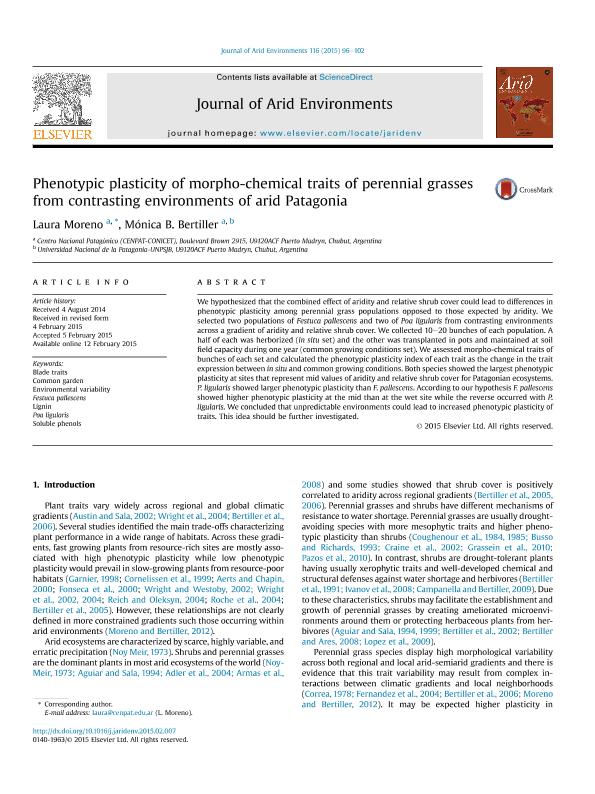Artículo
Phenotypic plasticity of morpho-chemical traits of perennial grasses from contrasting environments of arid Patagonia
Fecha de publicación:
05/2015
Editorial:
Academic Press Ltd - Elsevier Science Ltd
Revista:
Journal of Arid Environments
ISSN:
0140-1963
e-ISSN:
1095-922X
Idioma:
Inglés
Tipo de recurso:
Artículo publicado
Clasificación temática:
Resumen
We hypothesized that the combined effect of aridity and relative shrub cover could lead to differences in phenotypic plasticity among perennial grass populations opposed to those expected by aridity. We selected two populations of Festuca pallescens and two of Poa ligularis from contrasting environments across a gradient of aridity and relative shrub cover. We collected 10-20 bunches of each population. A half of each was herborized (. in situ set) and the other was transplanted in pots and maintained at soil field capacity during one year (common growing conditions set). We assessed morpho-chemical traits of bunches of each set and calculated the phenotypic plasticity index of each trait as the change in the trait expression between in situ and common growing conditions. Both species showed the largest phenotypic plasticity at sites that represent mid values of aridity and relative shrub cover for Patagonian ecosystems. P.ligularis showed larger phenotypic plasticity than F. pallescens. According to our hypothesis F.pallescens showed higher phenotypic plasticity at the mid than at the wet site while the reverse occurred with P. ligularis. We concluded that unpredictable environments could lead to increased phenotypic plasticity of traits. This idea should be further investigated.
Archivos asociados
Licencia
Identificadores
Colecciones
Articulos(CCT-CENPAT)
Articulos de CTRO.CIENTIFICO TECNOL.CONICET - CENPAT
Articulos de CTRO.CIENTIFICO TECNOL.CONICET - CENPAT
Citación
Moreno, Laura; Bertiller, Monica Beatriz; Phenotypic plasticity of morpho-chemical traits of perennial grasses from contrasting environments of arid Patagonia; Academic Press Ltd - Elsevier Science Ltd; Journal of Arid Environments; 116; 5-2015; 96-102
Compartir
Altmétricas




